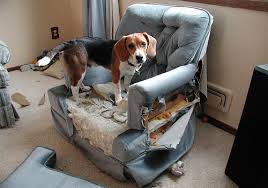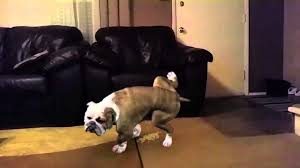Dogs with separation anxiety can destroy a house in a day…but they can improve with training and management.
 You are at your wit’s end. You were gone for less than a hour, and when you returned home, your dog destroyed your new sofa, defecated on your antique oriental rug, and inflicted deep gouges in the just painted front door frame.
You are at your wit’s end. You were gone for less than a hour, and when you returned home, your dog destroyed your new sofa, defecated on your antique oriental rug, and inflicted deep gouges in the just painted front door frame.
 You have tried leaving him in the backyard, but he chewed through the fence and got picked up by animal control.
You have tried leaving him in the backyard, but he chewed through the fence and got picked up by animal control.
 You tried crating him, but he scraped his toenails bloody and broke a canine tooth trying to dig and chew through the crate door. When you left him in the garage, he tore up everything within reach to shreds.
You tried crating him, but he scraped his toenails bloody and broke a canine tooth trying to dig and chew through the crate door. When you left him in the garage, he tore up everything within reach to shreds.
 When you left him in a covered chain link dog pen on the back patio, you got complaints from three different neighbors about his non stop barking and howling. You’ve even tried showing him the damage and punishing him for it, but it hasn’t helped. You hate to think of giving him up, but you don’t know what to do with him. If he would only behave himself when you are way from home.
When you left him in a covered chain link dog pen on the back patio, you got complaints from three different neighbors about his non stop barking and howling. You’ve even tried showing him the damage and punishing him for it, but it hasn’t helped. You hate to think of giving him up, but you don’t know what to do with him. If he would only behave himself when you are way from home.
Separation anxiety is a behavioral problem that results from a dog’s natural instinct to want to be near other members of his pack. It is a normal survival instinct, but one that can often be derailed early in a pups life through proper conditioning.
True separation anxiety , however, is a condition that’s widely over diagnosed. Many dogs diagnosed with this serious behavior problem are in fact afflicted instead with isolation distress; a less intense behavior in which the dog just can;t tolerate being left alone. With true separation anxiety, the dog can’t tolerate being separated from a specific person with whom he’s bonded very closely. Isolation distress, while still a different behavior, is easier to modify than the full blown panic attack that defines true separation anxiety.
Conditioned Response
Either way, it’s not easy. Separation anxiety is a panic attack-your dog’s classically conditioned response to the terror of being left alone.When you walk out the door, your dog doesn’t sit around and muse about whether or not to eat the sofa. Separation anxiety behavior is not a conscience choice, it just happens.
In fact, the anxiety happens before you even leave the house; your dog can tell from your morning routine whether this is a get-up-and -go-to-work-day (which leaves him home alone) or a relax-and-stay-at-home-day.
As soon as your dog determines it’s a work day, he starts to worry, and every step in the routine increases his anxiety. The 5 am alarm clock. The rush to put him out to potty and then toss him his food dish. The shower and shave. The suit and shiny shoes instead of blue jeans and sneakers. Coffee and a banana instead of bacon and eggs. The grab for the briefcase and car keys, the pause at the front door for dramatic hugs and kisses, and the fervent admonitions to behave himself while your gone.
 Phew! By the time the door closes in his face and you rush down the sidewalk to the car, your dog is already worked up into a high state of arousal. He makes no conscience decision to go on a destruction binge-he is simply stressed to the max. Effective ways for him to relieve his stress include chewing, digging, urinating, defecating and vocalizing.
Phew! By the time the door closes in his face and you rush down the sidewalk to the car, your dog is already worked up into a high state of arousal. He makes no conscience decision to go on a destruction binge-he is simply stressed to the max. Effective ways for him to relieve his stress include chewing, digging, urinating, defecating and vocalizing.
Anxiety or Hijinks?
Most separation anxiety behavior happens within 30 minutes of the owner’s departure and within a similar period before the owner’s anticipated return.
 This is one of the keys to determining whether his behavior is truly an anxiety reaction or simply a bout of puppy hijinks. Others include generalized destruction (boredom) as opposed to destruction directed at escape routes (doors and windows, chewing through walls) and clinging closely and with intensity to the owner’s heels as she moves about the home, even when she’ not preparing to leave.
This is one of the keys to determining whether his behavior is truly an anxiety reaction or simply a bout of puppy hijinks. Others include generalized destruction (boredom) as opposed to destruction directed at escape routes (doors and windows, chewing through walls) and clinging closely and with intensity to the owner’s heels as she moves about the home, even when she’ not preparing to leave.
 If you can leave and come back in an hour to an unscathed home but four hours puts him over the top, chances are your dealing with boredom, excessive energy, or a house training issue rather than true separation anxiety. Some dogs will become destructive in their efforts to go outside to relieve themselves if they are very committed to not soiling in the house.
If you can leave and come back in an hour to an unscathed home but four hours puts him over the top, chances are your dealing with boredom, excessive energy, or a house training issue rather than true separation anxiety. Some dogs will become destructive in their efforts to go outside to relieve themselves if they are very committed to not soiling in the house.
If, on the other hand, your dog displays immediate signs of anxiety prior to or upon your exit and some or all of his behavior matches the other determining factors, he’s a candidate for SA retraining. If you can just get the anxious dog through the first half hour or so, and avoid raising his anxiety level at homecoming time, you are usually home free. Simple-but not easy.
This task is best accomplished through a program of counter conditioning and desensitization (CC&D)-fancy terms to describe getting your dog to like something he now intensely dislikes or fears. In this case, the “something” is being left alone.
The challenge with using CC&D for separation anxiety is that ideally you start with a very low level stimulus that the dog can tolerate, associate it with something wonderful (like the dog’s favorite treats or toys) and gradually work up to a level of normal stimulus , while taking care not to trigger the unwanted response during the process.
If you are desensitizing a dog to loud noises, for example, it is relatively easy to prevent his exposure to noisy environments between training sessions. It is considerably more difficult for the average pet owner to design a schedule that leaves the dog alone for no more than a few seconds at first, then minutes, then hours, during the weeks or months that it takes to build his tolerance for being alone. If you are truly committed to working through the problem, and have the time and energy, then you will get through this.
Managing Your Pet
So, where do you start when you can’t confine him, you trust trust him loose in your house or yard, and you can’t punish him? What are you supposed to do with a crazed dog who is rapidly destroying everything you possess. You need to do two things: hurt himself or destroy things around him.
- Using counter conditioning and desensitization, teach him that it is safe to be left alone.
Let’s start with the easy one: managing the environment. That means not leaving him alone until he decides it’s okay to be left alone. You might be able to find a friend, neighbor or relative who is home during the day, where he can stay and be safe. Perhaps you are fortunate enough to work in a place where your dog could come to the office with you, it never hurts to ask.
 Doggie daycare is another excellent option. Commercial daycare centers are thriving in an increasing number of communities around the country, there might be a good one near you. Be sure the daycare operator knows your dog has separation anxiety and understands how to deal with it-that he can’t be left alone or punished for anxiety-related behavior.
Doggie daycare is another excellent option. Commercial daycare centers are thriving in an increasing number of communities around the country, there might be a good one near you. Be sure the daycare operator knows your dog has separation anxiety and understands how to deal with it-that he can’t be left alone or punished for anxiety-related behavior.
 Sometimes, although very rarely, getting another dog can help. It’s more likely to be beneficial if your dog suffers from isolation distress rather than true separation anxiety. If you considering adding a canine companion, you should only get a second dog because YOU want one and are committed to keeping the newcomer whether it helps your dog’s problem or not. Be careful-you could end up with two dogs with separation anxiety/destructive behavior.
Sometimes, although very rarely, getting another dog can help. It’s more likely to be beneficial if your dog suffers from isolation distress rather than true separation anxiety. If you considering adding a canine companion, you should only get a second dog because YOU want one and are committed to keeping the newcomer whether it helps your dog’s problem or not. Be careful-you could end up with two dogs with separation anxiety/destructive behavior.
Finally, there are pharmaceuticals that have appeared on the market relatively recently that purport to help with resolving a multitude of canine behavior problems. Clomicalm is one of the most commonly prescribed for separation anxiety, but must be used in conjunction with a good behavior modification program in order to be truly effective, the drug alone will not solve the problem.
Maximized Training
A behavior modification program will help your dog understand that he can survive by being left alone. Depending on the severity of the problem, this may happen relatively quickly, or it may take a long time, possibly years in my case, and never completely be resolved, although my situation was eventually resolved, although it took years of dedication and patience. If you have a Velcro dog who can’t even tolerate you being in the other room, you will need to start with very small steps. Here’s one program for working with separation anxiety and isolation distress:
 1.) Teach your dog to accept a tether with you standing right next to him. When he is comfortable on the tether take on step away and say “yes” before he has a chance to get upset (or click your clicker if he is clicker trained) then step back to him and feed him a high value reward. Repeat this step until he shows no sign of anxiety when you are one step away. Be sure that you remain very matter of fact about stepping away. If you get excited or emotional, so will he.
1.) Teach your dog to accept a tether with you standing right next to him. When he is comfortable on the tether take on step away and say “yes” before he has a chance to get upset (or click your clicker if he is clicker trained) then step back to him and feed him a high value reward. Repeat this step until he shows no sign of anxiety when you are one step away. Be sure that you remain very matter of fact about stepping away. If you get excited or emotional, so will he.
2.) Now, gradually increase the length of time that you remain one step away before you say “yes” or click, and return , until he will tolerate your one step distance for a full minute or longer. Vary the longer times with shorter ones, so he doesn’t start to get anxious about the exercise getting harder and harder each time. You want him to never know how long you will be gone, and at the same time you are teaching him that you will always return.
3.) Now, take two steps away, say “yes” and immediately return to him and feed him his reward. Repeat at this distance until he is comfortable with you being two steps away, then again gradually increase the time at this distance.
4.) Very gradually increase the distance, repeating the exercise at each new step until he is calm, then increasing the time at a new distance. If he panics at any point, you have moved too quickly. Go back to the previous distance and work there again until he is calm. Then take another half step, if necessary, to avoid triggering his panic. Many owners make the mistake of trying to move too far too fast.
5.) When he will remain calm while you walk to the other side of the room, sit down and read a magazine,you are ready for the next phase. Start the exercise as before, but this time walk to the doorway of another room, step outside briefly, say “yes” and step back into the room before he has the chance to get upset that you are out of sight. Return and return.
Repeat this until he is calm about you stepping out of the room, and then gradually increase the length of time that you remain out of sight.
6.) Now, sometimes close the door as you step out of the room, briefly at first, then for longer periods.
7.) Do the same exercise with each of the doors leading from the room, including the door that leads outside. Sometimes leave the door open, sometimes close it.
Be sure to return and reward each time before your dog goes into panic mode. If he starts acting anxious at any time, slow down, and go back to a part of the exercise that he can tolerate. Then, when he is calm, proceed more slowly to the step that upset him.
8.) Now, take him off the tether and repeat Step 6, closing the door each time to prevent him from following you out of the room. Start with very brief departures, so he doesn’t have time to start digging or chewing at the door. Gradually, increase the length of time you are out of room, but remember to intersperse the longer ones with short ones so he never knows how long you will be gone. Remember too, to remain calm yourself. If you start getting anxious or excited about the process, so will he.
 9.) When he is comfortable with you stepping outside for a few minutes, start adding bits of your departure routine to the exercise. Pick up your keys, step outside briefly, return, “Yes” and reward. Then put the keys down. Go outside, open and close the car door, then come back inside. “Yes” and reward if he remains calm. As he gets better with pieces of the routine, add more pieces.
9.) When he is comfortable with you stepping outside for a few minutes, start adding bits of your departure routine to the exercise. Pick up your keys, step outside briefly, return, “Yes” and reward. Then put the keys down. Go outside, open and close the car door, then come back inside. “Yes” and reward if he remains calm. As he gets better with pieces of the routine, add more pieces.
Assuming that you drive a car to work or school, the next step is to actually start the car engine, then come back inside and reward. Start the car engine, then vary the amount of time you wait before coming back inside the house to reward. Drive down the driveway, then drive back to the house, come back in and reward. Your goal is to gradually increase the length of time you can be outside to 30 minutes or more. If you can hit the magic 30 minute mark, you are well on your way to success.
Pacing is the Key
Be sure to proceed through these ten steps at a pace that your dog can tolerate. Short, successful sessions at first (five to ten minutes) are better than long, frustrating sessions that end in failure. You may be able to proceed through steps in a week or two if your dog’s separation anxiety is mild, but is more likely that it will take you several weeks or months to work up to 30 minutes. If you aren’t making any progress at all, fairly early in the program, talk to your veterinarian about adding Clomicalm to the equation.
If you are using Clomicalm, you will eventually have to wean your dog off the medication. I used a Kong as a “Surrogate Mother” for my dog. Each time I left the house, I would leave my dog a special stuffed Kong. As soon as I returned in the evening, I would pick the Kong up and place it out of sight. She was only allowed access to this Kong when I was not home.
Fixing separation anxiety is hard work, and it’s easy to get frustrated with your dogs destructive behavior. Remember that he’s not choosing to do it out of spite or malice, he is panicked about his own survival without you-his pack, there to protect him. It’s not fun for him-he lives in the moment, and the moments you are gone are long and terrifying.
All Natural Solutions-Bach Flower Remedies
 Honeysuckle: This is useful for many of the straightforward cases of separation anxiety; where the dog is just “feeling the blues” because of the owners absence. He may express this by soulful howling. Honeysuckle is for states of “I want things back to the way they were before” and so would be useful if the dog were pining for an owner who will not return, possibly who has died.
Honeysuckle: This is useful for many of the straightforward cases of separation anxiety; where the dog is just “feeling the blues” because of the owners absence. He may express this by soulful howling. Honeysuckle is for states of “I want things back to the way they were before” and so would be useful if the dog were pining for an owner who will not return, possibly who has died.
 Gorse: This would be called for in a dog who is truly despairing, close to grief, over the absence of a beloved owner. Again, when an owner has passed away, a dog may pine bitterly and sometimes even give up the will to live. Gorse is a great re-builder of the vital force.
Gorse: This would be called for in a dog who is truly despairing, close to grief, over the absence of a beloved owner. Again, when an owner has passed away, a dog may pine bitterly and sometimes even give up the will to live. Gorse is a great re-builder of the vital force.
 Walnut: This remedy can help the dog to build up a sense of emotional independence, which is needed if he’s to feel secure on his own.
Walnut: This remedy can help the dog to build up a sense of emotional independence, which is needed if he’s to feel secure on his own.
 Willow: This can help the spoilt dominant type of dog that is actively resentful about being left alone.
Willow: This can help the spoilt dominant type of dog that is actively resentful about being left alone.
 Vine: This can help to reduce the dogs urge to dominate and regard himself as the Alpha in the pack.
Vine: This can help to reduce the dogs urge to dominate and regard himself as the Alpha in the pack.
Directions on how to give the Bach Remedies to animals:
Rescue Remedy can be rubbed on the animals gum, ears or paws as needed or you can add 2 drops to the drinking water.
To make a treatment bottle you get a 30ml/1oz mixing bottle and add 2 drops of each Remedy. You can combine up to 6 or 7 Remedies in a treatment bottle.
As preservative (optional) you can add 1 tsp of vegetable glycerin. Then you fill the bottle with water.
From this mixture you give your pet 4 drops, 4 times a day until it feels better. You can also add 1 drop from each remedy to your pets drinking bowl, or rub a little on their paws or ears 4 times a day.
If you make the commitment to modifying his behavior and succeed in making him brave about being alone, you will not only have saved your home from destruction, you will have enhanced the quality of your dog’s life immensely, and perhaps saved him from destruction too.
The Whole Dog Journal
Bach Flower Remedies







